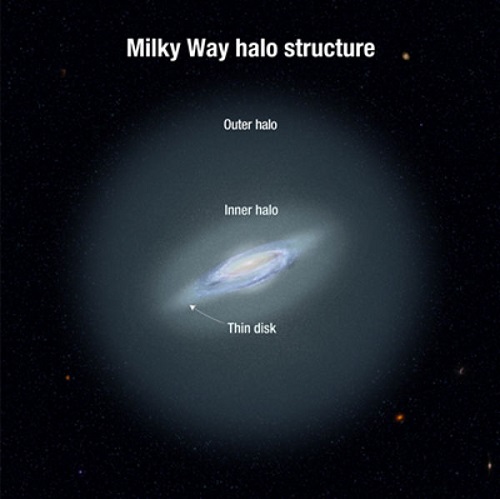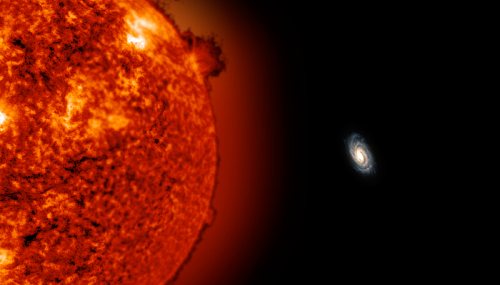Not long ago we talked about what the Milky Way would look like when seen from afar. I had mentioned Poul Anderson’s World Without Stars, which appeared in Analog in 1966 under the title The Ancient Gods. In the Anderson tale, a starship crew is sent to make contact with a recently discovered technological civilization that lives on a world hundreds of thousands of light years from the galactic core. Now a recent paper deepens our understanding of this environment deep in the galaxy’s outer halo.
Recall that the Milky Way is about 100,000 light years in diameter, and that the distance to the nearest large galaxy is roughly 2,500,000 light years. Anderson’s crew is over 200,000 light years from the core, which puts them in the outer halo, a sparse spherical volume of space that stretches out 500,000 light years, well beyond the familiar, highly visible disk. While the stars in the galactic disk are on nearly circular orbits in the plane of the galaxy, the halo stars are on more elliptical orbits that are randomly oriented, so that while inner halo stars can pass through the disk, most of their lives are spent well above or below the plane of the galaxy. The inner, visible part of the halo is where we find the ancient, metal-poor globular clusters.

Image: Structure of the Milky Way, showing the inner and outer halo. Credit: NASA, ESA, and A. Feild (STScI).
Astronomer John Bochanski (Haverford College, PA) and team, however, are looking out well beyond the globular clusters. The researchers note in their paper in The Astrophysical Journal Letters that there are few known outer halo stars at distances over 120 kiloparsecs, which works out to about 390,000 light years — in fact, the list of known halo stars at this distance yields a grand total of seven, with the paper adding an additional two. The galaxy’s outer halo, we learn, is largely unexplored, but as we’ll see, it holds implications for galaxy formation theories.
The team’s recent paper outlines the discovery of two cool red giants — ULAS J0744+25 and ULAS J0015+01 — that appear to be the most distant Milky Way stars yet detected, at distances of 775,000 and 900,000 light years respectively. The work draws on observations from the UKIRT Infrared Deep Sky Survey and Sloan Digital Sky Survey, with spectroscopic studies using the 6.5m telescope at the MMT Observatory in Arizona. The newly discovered stars are five times more distant than the Large Magellanic Cloud and almost a third of the way to the Andromeda galaxy. At these distances, both Andromeda and the Milky Way should appear quite faint in the visible spectrum. If Anderson’s crew were here, the night sky would be dark indeed.
The image below brightens the Milky Way to give some sense of its distance from these stars.

Image: This simulated image demonstrates how small the Milky Way would look from the location of ULAS J0744+25, nearly 775,000 light years away. This star, along with ULAS J0015+01, are the most distant stars ever associated with our Galaxy, and are about five times further away than the Large Magellanic Cloud, one of the Milky Way’s closest galactic neighbors. Credits: Visualization Software: Uniview by SCISS Data: SOHO (ESA & NASA), John Bochanski (Haverford College) and Jackie Faherty (American Museum of Natural History and Carnegie Institute’s Department of Terrestrial Magnetism).
Bochanski’s team has been looking at formation models for the Milky Way, an interesting issue given that, as he explains, “Most models don’t predict many stars at these distances. If more distant red giants are discovered, the models may need to be revised.” The halo itself may be the result of mergers over the galaxy’s lifetime with numerous smaller galaxies, with outer stars the remnant population of what had once been intact dwarf galaxies. If this is correct, we can study these outer halo stars as a way of probing the formation history of the entire spiral. The team hopes to identify up to 70 red giants in the halo, refining its selection criteria and aiding next generation surveys like Gaia that will help us deepen our catalog in this distant region.
The paper is Bochanski et al., “The Most Distant Stars in the Milky Way,” The Astrophysical Journal Letters, Volume 790, Issue 1, article id. L5 (abstract / preprint).



I don’t understand how the simulated image could be correct. At 800 kly the galaxy would cover over 7 degrees of the sky (15x the angular diameter of the moon), The image seems to make the galaxy quite small to me.
Alex, I’m checking with John Bochanski about this and hope to have a comment in the next day or so. Will report back with his response.
I cannot find the distance of the virtual observer from the star in this description. If that were 1 AU, the red giant would fill a huge part of the sky, I guess.
Alex, Dr. Bochanski responds as follows:
“Thanks for writing this story. That image has been cropped and modified many times, so the scale has changed many times. But your reader is correct, 7 degrees is about the size of the MW’s disk from this distance (however the entire disk would probably not be visible). Perhaps a comparison with the moon may have been a better idea, but its too late for that.
EIther way, our Galaxy looks much different from these stars.”
I couldnt find where it says how they determined the distance: I’m very curious about that. Anyone have access to the original article (behind paywall)?
Also, what is the apparent magnitude of these stars? I wonder how faint they are.
How big would the Andromeda galaxy My look in their skies?
How does a single piece of art get cropped and modified many times? Every news item I have seen on this subject shows the exact same artwork. Perhaps someone just did not bother to do their homework.
Kamal,
Paul provided the link to the pre-print right at the bottom of the article. I’ve skimmed through the pre-print, and the answers you seek are in there.
900,000 LY is over a third of the way to Andromeda, I wonder what the typical distances between stars in the outer halo is, maybe a story about the stepping stones between the galaxies?
The funny thing is, these are large stars and are therefore relatively young (even though they are red giants). Does this imply there is (or was) a small amount of active star formation in the halo?
I remember there is an older paper surveying A-type stars out to large galactic radius also (although not as far as this by any stretch, from memory it was about 30kpc)
kzb, I wondered the same but in the paper they say there is no evidence (yet) of gas clouds in the outer halo from which stars could form. Also, red giants are generally end-of-life stars that could be many billions of years old, and therefore could have been either ejected from the MW or remnants of a colliding dwarf galaxy. This is all discussed in the paper.
Laniakea: Newly identified galactic supercluster is home to the Milky Way
September 3, 2014 – 1 hour ago
Astronomers using the National Science Foundation’s Green Bank Telescope (GBT)—among other telescopes—have determined that our own Milky Way galaxy is part of a newly identified ginormous supercluster of galaxies, which they have dubbed “Laniakea,” which means “immense heaven” in Hawaiian.
This discovery clarifies the boundaries of our galactic neighborhood and establishes previously unrecognized linkages among various galaxy clusters in the local Universe.
“We have finally established the contours that define the supercluster of galaxies we can call home,” said lead researcher R. Brent Tully, an astronomer at the University of Hawaii at Manoa. “This is not unlike finding out for the first time that your hometown is actually part of much larger country that borders other nations.”
The paper explaining this work is the cover story of the September 4 issue of the journal Nature.
Superclusters are among the largest structures in the known Universe. They are made up of groups, like our own Local Group, that contain dozens of galaxies, and massive clusters that contain hundreds of galaxies, all interconnected in a web of filaments. Though these structures are interconnected, they have poorly defined boundaries.
To better refine cosmic mapmaking, the researchers are proposing a new way to evaluate these large-scale galaxy structures by examining their impact on the motions of galaxies. A galaxy between structures will be caught in a gravitational tug-of-war in which the balance of the gravitational forces from the surrounding large-scale structures determines the galaxy’s motion.
By using the GBT and other radio telescopes to map the velocities of galaxies throughout our local Universe, the team was able to define the region of space where each supercluster dominates.
“Green Bank Telescope observations have played a significant role in the research leading to this new understanding of the limits and relationships among a number of superclusters,” said Tully.
Full article here:
http://phys.org/news/2014-09-laniakea-newly-galactic-supercluster-home.html